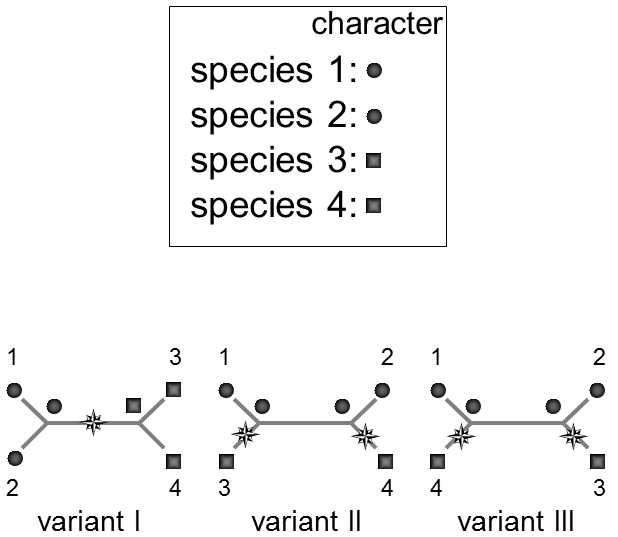XXIII.5.2 Homologies and homoplasies can also be distinguished using the maximum parsimony principle
If the relevant paleontological data are not available or do not permit us to draw unambiguous conclusions and if approaches based on comparison of the ontogeneses of the given forms of the trait similarly fail, we can attempt to differentiate homology and homoplasy on the basis of the maximum parsimony principle.Themaximum parsimony principle as employed in phylogenetics states that that the most probable course of cladogenesis is the one that can explain the distribution of the individual forms of traits within the phylogenetic tree through the smallest number of anagenetic changes, i.e. smallest number of transitions from one form of the trait to another.Thus, in looking for the maximally parsimonious tree (Fig. XXIII.5), first all the conceivable trees are created for the studied species, on which the studied species form only the terminal branches, where the form of the trait carried is drawn in next to each species.

Fig. XXIII.5 The maximum parsimony principle in phylogenesis. The upper table depicts the distribution of two forms of a binary trait (circle, square) for four studied species. The lower part of the figure depicts all three variants of unrooted trees that can be created for the four species, with designation of the values of the trait for each of the taxa and for two hypothetical ancestors of two pairs of species. The asterisks correspond to places of evolutionary changes of one form of the trait into the other. It is apparent from the figure that variant I is maximally parsimonial as, for explanation of the existing distribution of the two forms of the trait, it is sufficient to assume only one evolutionary change.
For all the hypothetical ancestors, i.e. for the inner branches of the tree, the most probable forms of the individual traits are also estimated.The most probable combination of forms of traits for the hypothetical ancestor is then chosen so that the total number of evolutionary changes cable of explaining the distribution of traits in the real studied specie sis as small as possible.If, for example, sister species 1 and 2 carry the trait in form A, then it will be assumed that this form of the trait was also carried by their common ancestor.For each created tree, the number of evolutionary changes in all the traits required to explain the distribution of the individual forms of the traits in the studied species and the tree with the smallest number of necessary changes, i.e. the maximally parsimonious tree, will be considered to be the most probable scheme of cladogenesis for the given phylogenetic line.For a small number of species and small number of traits, the maximally parsimonious tree can be sought for “manually”; however, in the vast majority of cases, a sufficiently powerful computer must be used to solve this task.
The topology of the resultant tree corresponds to the distribution of most of the traits, i.e. minimizes the overall number of changes in all the traits together, but is usually in contradiction with the distribution of some traits.Traits whose distribution corresponds to the topology are probably homologies.On the other hand, traits whose distribution is contrary to this topology, i.e. traits whose distribution would best suit some other topology, are most probably homoplasies.
